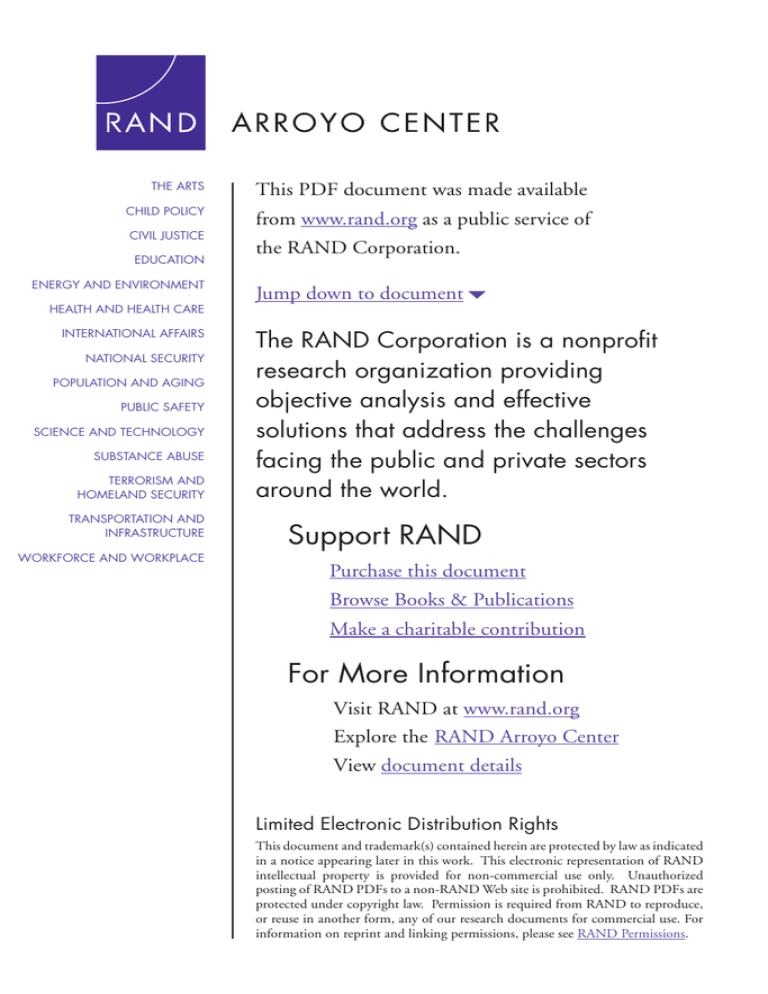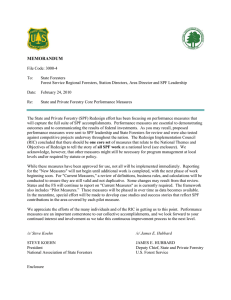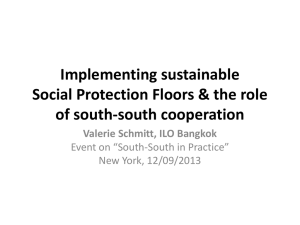6 The RAND Corporation is a nonprofit from
advertisement

THE ARTS This PDF document was made available CHILD POLICY from www.rand.org as a public service of CIVIL JUSTICE EDUCATION ENERGY AND ENVIRONMENT HEALTH AND HEALTH CARE INTERNATIONAL AFFAIRS NATIONAL SECURITY POPULATION AND AGING PUBLIC SAFETY SCIENCE AND TECHNOLOGY SUBSTANCE ABUSE TERRORISM AND HOMELAND SECURITY TRANSPORTATION AND INFRASTRUCTURE WORKFORCE AND WORKPLACE the RAND Corporation. Jump down to document6 The RAND Corporation is a nonprofit research organization providing objective analysis and effective solutions that address the challenges facing the public and private sectors around the world. Support RAND Purchase this document Browse Books & Publications Make a charitable contribution For More Information Visit RAND at www.rand.org Explore theRAND Arroyo Center View document details Limited Electronic Distribution Rights This document and trademark(s) contained herein are protected by law as indicated in a notice appearing later in this work. This electronic representation of RAND intellectual property is provided for non-commercial use only. Unauthorized posting of RAND PDFs to a non-RAND Web site is prohibited. RAND PDFs are protected under copyright law. Permission is required from RAND to reproduce, or reuse in another form, any of our research documents for commercial use. For information on reprint and linking permissions, please see RAND Permissions. This product is part of the RAND Corporation monograph series. RAND monographs present major research findings that address the challenges facing the public and private sectors. All RAND monographs undergo rigorous peer review to ensure high standards for research quality and objectivity. A Stability Police Force for the United States Justification and Options for Creating U.S. Capabilities Terrence K. Kelly, Seth G. Jones, James E. Barnett II, Keith Crane, Robert C. Davis, Carl Jensen Prepared for the United States Army Approved for public release; distribution unlimited ARROYO CENTER The research described in this report was sponsored by the United States Army under Contract No. W74V8H-06-C-0001. Library of Congress Cataloging-in-Publication Data is available for this publication. ISBN 978-0-8330-4653-6 The RAND Corporation is a nonprofit research organization providing objective analysis and effective solutions that address the challenges facing the public and private sectors around the world. RAND’s publications do not necessarily reflect the opinions of its research clients and sponsors. R® is a registered trademark. © Copyright 2009 RAND Corporation Permission is given to duplicate this document for personal use only, as long as it is unaltered and complete. Copies may not be duplicated for commercial purposes. Unauthorized posting of RAND documents to a non-RAND Web site is prohibited. RAND documents are protected under copyright law. For information on reprint and linking permissions, please visit the RAND permissions page (http://www.rand.org/publications/permissions.html). Published 2009 by the RAND Corporation 1776 Main Street, P.O. Box 2138, Santa Monica, CA 90407-2138 1200 South Hayes Street, Arlington, VA 22202-5050 4570 Fifth Avenue, Suite 600, Pittsburgh, PA 15213-2665 RAND URL: http://www.rand.org To order RAND documents or to obtain additional information, contact Distribution Services: Telephone: (310) 451-7002; Fax: (310) 451-6915; Email: order@rand.org Summary This study asks several questions. First, is a Stability Police Force (SPF) necessary? An SPF is a high-end police force that engages in a range of tasks such as crowd and riot control, special weapons and tactics (SWAT), and investigations of organized criminal groups. In its ability to operate in stability operations, it is similar to such European forces as the Italian Carabinieri and French Gendarmerie. Its focus on highend tasks makes it fundamentally different from UN or other civilian police, who deal with more routine law and order functions. It is also different from most military forces, which are generally not trained and experienced to conduct policing tasks in a civilian environment. Second, if an SPF is necessary, what should it look like? This includes considering such issues as: its objectives, tasks, and size; its speed of deployment; its institutional capabilities; where it should be headquartered in the U.S. government and how it should be staffed (standing force, reserve force, and hybrid force); and its cost. Our conclusions are based on several facts and assumptions. First, it would be optimal to have SPF personnel with civilian police skills, orientation, and perspective do high-end policing. This is because civilian police have more experience working with the civilian population than do military personnel under normal circumstances. Additionally, police skills are created and maintained only by constant use, and only police forces that work daily with civilians can exercise the maximum number of SPF policing functions among the civilian population. Second, we assume that a new agency would be difficult to establish. It would be politically challenging and face resistance from a range of organizations in the Departments of Justice, Homeland Security, xiii xiv A Stability Police Force for the United States and State currently engaged in policing. It would need some additional overhead, and would take significant time to establish. All personnel and all additional administrative overhead personnel would have to be recruited. Training facilities and programs would have to be created and established, rather than modified or expanded, as they would have to be if an SPF becomes part of an existing agency. Third, we assumed that stability operations are feasible only when the intervening authorities care a great deal about the outcome, and even then, only in relatively small countries or regions. We limited our SPF size estimates to countries under 20 million for reasons of cost and staffing. Specifically, we assumed that an SPF that cost more than $1 billion per year would be politically unpopular and would be difficult to get funded. If U.S. policymakers wanted to deploy an SPF to large countries with a hostile security environment, there are several options to deal with the shortfall: (a) an SPF size could be increased by augmenting it with additional federal, state, or local police from the United States; (b) an SPF could only be deployed to specific regions or cities in the country; (c) an SPF could be supplemented with highend police from other countries; (d) an SPF could be supplemented with military police (MPs); or (e) an SPF could be supplemented by local police forces from the host country. If a significantly larger force was feasible, this would make the military option more attractive, as the management challenge for civilian agencies would be larger, which already call for significant expansion of management capabilities. The Need for a Stability Force Our analysis clearly indicates that the United States needs an SPF or some other way to accomplish the SPF mission. Stability operations have become an inescapable reality of U.S. foreign policy. Establishing security with soldiers and police is critical because it is difficult to achieve other objectives—such as rebuilding political and economic systems—without it. The cost of not fixing this gap is significant. The United States will continue to experience major challenges in stability operations if Summary xv it does not have this policing capacity. These challenges include creating the ability to establish basic law and order, as well as defeat or deter criminal organizations, terrorists, and insurgents. In some cases, allied countries may be able to fill this gap. Allies did this effectively in Bosnia and Kosovo, both of which were successful in establishing security. In other cases, the United States may not be able to count on allied support. The United States should not depend on allies to supply these capabilities, because doing so would limit U.S. freedom of action on the international stage. Consequently, the United States should seriously consider building a high-end police capacity. Building an SPF This conclusion leads to several findings on the SPF’s make-up. Objectives and Tasks Analysis of stability operations over the past two decades indicates that an SPF should have two major objectives. The first is to help establish a secure environment in which people and goods can circulate safely, and where licit political and economic activity can take place free from intimidation. Recent history clearly indicates that external assistance is often needed to achieve this goal. The second is to help build a high-end indigenous policing capacity so that the host government can establish security on its own. An SPF’s tasks logically flow from these objectives. It should perform high-end policing tasks—identifying and deterring high-end threats, criminal investigations, SWAT, crowd control, and intelligence collection and analysis—and build the capacity of local high-end forces. An SPF will not solve all of the gaps that exist across the rule-of-law sector—or even the police forces—of the host nation, and should not try to; it is only one of several important players. Sizing an SPF A decision on the size of the SPF should be made based on affordability and requirements. Quantitative and qualitative work on recent stability operations shows that a number of internal and external variables affect xvi A Stability Police Force for the United States force requirements. Both types of variables can significantly influence the number of forces necessary and available. Consequently, there is no “correct” size for an SPF. Nevertheless, we can still make some rough calculations about sizing options. Based on an assessment of past stability operations and an examination of three scenarios (Macedonia, Cuba, and Cote d’Ivoire), we concluded that there are three main sizing options for an SPF that we would consider: 1,000 police; 4,000 police; and 6,000 police. It would be even more difficult and resourceintensive to mount stability operations in larger countries such as Iran, Pakistan, the Philippines, Nigeria, and Venezuela. Efforts of this size would require a national commitment beyond what is considered in this report. However, the maximum-size SPF considered in this report is based on assumptions about what is affordable. If a larger force was deemed desirable, some elements of this analysis might change. Deployment Speed In order to deploy alongside military forces and be prepared to fill the public security gap in a timely manner, an SPF should be able to position a battalion-sized unit for deployment in 30 days. Quick deployments provide an opportunity for high-end police forces to gain positional advantage against current or potential adversaries, such as criminal groups or insurgents. In the immediate aftermath of an intervention there is often a period of several weeks to several months during which the external interveners may enjoy some popular support and international legitimacy, while potential spoilers may have insufficient time to organize. During this period, efforts by the interveners can prevent a spiral of conflict that becomes an insurgency. By employing a simple crisis-evolution framework, we conclude that in most situations an SPF will have significant time to prepare for deployment—over five months on average. Overall, however, we concluded that a rapid reaction capability of 30 days should be sufficient under virtually all scenarios. In practice, this would involve moving up to a battalion-sized unit to the port of embarkation within 30 days from notification of the decision to deploy. This timeline is consistent with the calculations of other international police forces. Summary xvii Headquarters in the U.S. Government Of the options considered, this research indicates that the U.S. Marshals Service (USMS) would be the most likely to successfully field an SPF, under the assumptions that an MP option would not be permitted to conduct policing missions in the United States outside of military installations except under extraordinary circumstances, and that doing so is essential to maintaining required skills. While the USMS would have significant challenges in building up to the needed size, it has many of the needed policing skills and could develop the remaining through the hybrid staffing options discussed below. The MP Corps has the opposite problem: it has the capacity to take on the task, and arguably it has the skills due to its efforts in Iraq and Afghanistan. However, its ability to maintain these skills during periods when it is not engaged in large-scale stability operations is constrained by the limits placed on its ability to perform civilian policing functions by the Posse Comitatus Act. Without relief from this constraint, it could not take advantage of the opportunities provided by the hybrid staffing option to develop and maintain the needed skills. Furthermore, its focus is contingent on the priorities of the Army leadership, and were the Army to revert to the major combat focus it had held from the Vietnam era until very recently, it could put the SPF’s functionality in danger. To make this determination, we identified three civilian options and one military option that were assessable using a method based on each option’s tactical and institutional suitability. These were the U.S. Marshals Service in the Department of Justice, the U.S. Secret Service in the Department of Homeland Security, the Bureau of International Narcotics and Law Enforcement Affairs (INL) in the Department of State, and the U.S. Army’s Military Police. In addition, we considered using an existing MP unit and creating a new agency to house an SPF. In deciding which agencies to evaluate, we looked for congruence between (a) an SPF’s tasks and (b) the tasks and missions of a range of agencies in the Departments of Justice, State, Homeland Security, Defense, and other organizations. This ruled out some agencies— such as the Federal Bureau of Investigation (FBI), Drug Enforcement Administration (DEA), and State Department’s Bureau of Diplomatic xviii A Stability Police Force for the United States Service—because they do not perform most of an SPF’s policing tasks as discussed in Chapter Two. It also ruled out other Department of Defense options, such as the Marine Corps, as its policing capabilities are much smaller than the Army’s. Our process resulted in the set of options consisting of agencies that were the best suited to take on the SPF missions in their respective departments (e.g., the U.S. Marshals Service as the best fit in the Department of Justice). To assess these four options, we focused on tactical and institutional suitability. To assess what each of the options could do in the future, we started with each agency’s inherent capacity to perform SPF tasks today and over the long term, and then we looked at whether its institutional capabilities would be likely to improve its tactical performance to predict how it would most likely perform. Since a relative ranking of options is all that is required to determine which is best, this method provides adequate results. Based on this methodology, we concluded that the U.S. Marshals Service and the MP options dominate all others, but that neither dominates the other. However, there are other important distinctions between civilian and military options that remained to be considered, the principal of which is considered under the staffing discussion below. Additionally, we considered using existing MP units with robust predeployment training, as well as creating a new agency to house an SPF (see the appendix). The United States has a history of using military formations for policing functions, and this history clearly indicates that this is a suboptimal solution, and in particular less attractive than the MP SPF option. In making this conclusion, it should be stressed that we are not assessing current MP efforts in Iraq. In particular, that effort is far larger, in terms of both the scope of policing tasks and the necessary manpower, than any SPF could take on. In the context of a very large effort such as this, the SPF is best considered as a force provider capable of targeting the high-end policing functions but unable to do very large scale police training and mentoring effort such as those currently under way in Iraq, to say nothing of the enormous detention effort there. Most of what the MPs are doing in Iraq would be needed even if an SPF existed today. However, if authorization and funds for Summary xix an SPF were not forthcoming, training an MP unit to do this would be better than using untrained units. Creating a new agency in the Department of Justice would have few benefits over the USMS option, would likely be difficult to do, and would take additional time. This was not viewed as preferable to the USMS option. However, creating a new civilian agency within the Department of the Army would have one major advantage over the MP option: it would not be a military organization and so would probably be able to maintain a policing focus regardless of the emphasis in the larger Army. However, it might still not be able to perform policing functions domestically and, if so, would not have the same skills as a civilian police–based SPF—that is, the USMS option. Staffing The hybrid staffing option, which provides individuals with relevant civilian policing experience and SPF units with collective training opportunities, is more likely to facilitate the fielding of a tactically proficient SPF than a reserve or standing force. In fact, it was designed to have the greatest chance of doing this. In order to assess these options, we identified five criteria: Does the option provide personnel with the skills necessary for success? Does the option lend itself well to developing unit cohesion? Does the option allow for rapid deployment? What impact will the option have on affected organizations? What mission will the entity perform when not deployed? The hybrid option (USMS variant) does best at providing personnel with the diverse, real-world policing skills needed for the SPF function. It also allows for ample training time to build nonpolicing skills and unit cohesion. Certain law enforcement skills can only be gained through experience, so trying to develop them through training alone may not be advisable. In particular, under the USMS hybrid option, administrators would have the ability to influence SPF personnel assignments in the police organization where they would work when not deployed. This would provide high confidence that the full spectrum of needed skills would be acquired by the force members in the course of their day-to-day jobs. While the reserve option might provide some personnel with real-world policing skills, this could not xx A Stability Police Force for the United States be guaranteed, and the lack of control over the assignments of these personnel when not deployed would not allow the SPF leadership to manage their personnel as well as in the hybrid option. Under the standing option, personnel would likely acquire some skills but not others unless the mission, and in some cases the authorities, of the federal host agency were significantly increased. Furthermore, federal law enforcement agencies do not now perform the full range of tasks required of an SPF, so it would not be possible to provide SPF police with all desired skills in their normal jobs. The USMS hybrid option also provides an important nondeployed mission for the force: augmenting state and local agencies, many of which currently suffer from severe personnel shortages. While the Army hybrid option shares many desirable characteristics with the USMS hybrid option, and is logistically superior to it, the legal difficulties inherent in it are probably too great to overcome. Despite some occasions when military troops have been used in a civilian law enforcement capacity, embedding military personnel in civilian police agencies would be seen by the federal government, and by the military in particular, as an encroachment on powers historically and constitutionally afforded to the states and, by the Posse Comitatus Act, to civilians. For example, while none of the prospective parent organizations discussed here has organic world-class investigative skills or opportunities, civilian police under the hybrid option would have a better chance of working in one of the United States’ premier investigative organizations (e.g., the FBI, DEA, major crimes unit in a large metropolitan police department) than would military police officers. Cost Cost is an important factor in choosing among options. If the cost is high, the U.S. government may decide that an SPF is unaffordable, even if it would be more effective than current arrangements. Table S.1 shows the total cost estimates for the four options. Equipment costs were calculated by amortizing over seven years. As can be seen, the reserve option is the cheapest at $396 million per year for the large option. The hybrid civilian option is the next most expensive at $637 million. Because of the additional costs of providing facilities, the full- Summary xxi Table S.1 Total Cost Estimates (2007$ millions) Small Medium Large Military Reserves Full-Time Civilian Hybrid Civilian $167.7 $573.0 $906.8 $93.3 $278.6 $396.1 $157.2 $545.7 $870.0 $116.0 $410.2 $637.3 time civilian option is the next most expensive at $870 million per year, and the military option the most expensive at $907 million per year. Conclusions In summarizing, we examined both the downsides and upsides of an SPF. There are several possible downsides. First, building a competent SPF would cost money, and would require taking money from elsewhere in the U.S. government. Second, establishing an SPF would likely trigger bureaucratic resistance. Creating the SPF in any agency will create competition for authorities and funding. Third, staffing an SPF using the hybrid option outlined in Chapter Six could pose challenges. For example, local police agencies might resist losing key police officers and units, such as SWAT teams. In addition, the arrangements between organizations to loan SPF personnel to federal, state, and local agencies could get complicated the greater the number of agencies involved. Nonetheless, we believe the downsides are outweighed by the upsides discussed below. • An SPF would provide needed capabilities and might pay for itself, as it is cheaper than using military forces for policing tasks. –– Establishing security ultimately requires a combination of both military and policing efforts. SPF-like police forces are critical in conducting specialized patrols, countering organized criminal groups, performing crowd and riot control, and training and mentoring indigenous high-end police. Police performed these tasks better than soldiers. xxii A Stability Police Force for the United States –– The costs of creating an SPF are probably less than the cost of not having this capability at all. Since the end of the Cold War, the United States and other Western powers have been involved in an increasing number of stability operations abroad, from the Balkans and Haiti to Afghanistan and Iraq. Had the United States been able to establish law and order in any one of several of its interventions since the early 1990s, it is likely that this would have saved money and lives. Furthermore, an SPF is less expensive than a similarly sized military force, as illustrated in the table above. • The large SPF option (6,000 personnel) would provide additional capabilities over the smaller options at a reasonable cost. The cost ($637 million for the hybrid option) is a relatively small price to pay for this capability. The additional capability increases the number, size, and types of contingencies that can be handled. The cost savings realized by relieving military units of these missions could be greater than the costs of creating an SPF, as military units are considerably more expensive to man, maintain, and deploy. • Given that it is unlikely that MPs would be permitted to perform civilian policing tasks in the United States, the USMS, despite its capacity and management shortfalls, is the agency best suited to take on the SPF mission under the assumptions of this study. Placing the SPF in the USMS would place it where its members can develop the needed skills under the hybrid staffing option. Furthermore, the USMS has the broadest law enforcement mandate of any U.S. law enforcement agency and many of the required skills, though it would need to increase its capacity significantly. Furthermore, the Department of Justice stands at the center of the rule-oflaw effort, with lead roles in policing, judiciary, and corrections efforts. • The hybrid model provides the best mix of skills development and readiness opportunities. This model provides the broadest police skills, does well on developing unit skills and quick mobilization times, and provides significant domestic policing and homeland Summary xxiii security benefits by providing thousands of additional police officers across the United States. • If the decision is made to put the SPF in the Department of Defense, then the department should consider creating a new civilian policing agency within the Department of the Army to accommodate it. As recently as 2005, the MP Corps was focused primarily on its combat mission and had no intention of placing an increased emphasis on stability policing. While this has changed since the surge of MP units into Iraq in 2006, there is no guarantee that the change is permanent. Furthermore, U.S. Army policy states a clear bias against creating units that specialize in stability operations. A new civilian policing agency in the Department of the Army could create a policing orientation and leverage the institutional strengths of the Army to field the SPF. However, we believe that this would be less effective and more costly than the USMS hybrid option. These findings do not minimize the role that other U.S. agencies, especially the Department of Defense, must play in stability operations. The Army should continue to play a significant role in establishing security. U.S. military police will continue to be an essential player in the entire spectrum of policing tasks, especially in situations in which very large efforts and high levels of violence make their unique contribution invaluable. A civilian SPF must be deeply interlinked with other rule-of-law and law enforcement efforts and the U.S. military, especially military police, to effectively establish security. Furthermore, a USMS-based SPF would act as a force provider in critical situations. Indeed, we assess that it would be in the Army’s long-term interest to support the establishment of such a police force in the Department of Justice that can supplement its activities overseas.







